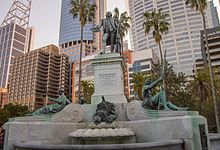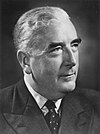
The population of Australia is estimated to be 27,174,900 as of 4 May 2024. Australia is the 56th most populous country in the world and the most populous Oceanian country. Its population is concentrated mainly in urban areas, particularly on the Eastern, South Eastern and Southern seaboards, and is expected to exceed 30 million by 2029.
Anglo-Celtic Australians is an ancestral grouping of Australians whose ancestors originate wholly or partially in the British Isles - predominantly in England, Ireland, Scotland and Wales, as well as the Isle of Man and Channel Islands.

Chinese Australians are Australians of Chinese origin. Chinese Australians are one of the largest groups within the global Chinese diaspora, and are the largest Asian Australian community. Per capita, Australia has more people of Chinese ancestry than any country outside Asia. As a whole, Australian residents identifying themselves as having Chinese ancestry made up 5.5% of Australia's population at the 2021 census.

Irish Australians are an ethnic group of Australian citizens of Irish descent, which include immigrants from and descendants whose ancestry originates from the island of Ireland.

Vietnamese Australians are Australians of Vietnamese descent. Vietnamese Australians are one of the largest groups within the global Vietnamese diaspora. At the 2021 census, 334,781 people stated that they had Vietnamese ancestry, representing 1.3% of the Australian population. In 2021, the Australian Bureau of Statistics estimated that there were 268,170 Australian residents who were born in Vietnam.
German Australians are Australians with German ancestry. German Australians constitute one of the largest ancestry groups in Australia, and German is the fifth most identified European ancestry in Australia behind English, Irish, Scottish and Italian. German Australians are one of the largest groups within the global German diaspora.
Sudanese Australians are people of Sudanese origin or descent living in Australia. The largest population of Sudanese Australians reside in Victoria (6,085).
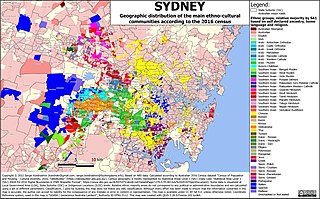
Sydney is Australia's most populous city, and is also the most populous city in Oceania. In the 2021 census, 5,231,147 persons declared themselves as residents of the Sydney Statistical Division–about one-fifth (20.58%) of Australia's total population. With a population density of 2037 people per square kilometre, the urban core has population density five times that of the greater region.

Serbian Australians, are Australians of ethnic Serb ancestry. In the 2021 census there were 94,997 people in Australia who identified as having Serb ancestry, making it a significant group with the global Serb diaspora.
Malaysian Australians refers to Malaysians who have migrated to Australia or Australian-born citizens who are of Malaysian descent. This may include Malaysian Chinese, Malays, Malaysian Indians, Orang Asal, mixed Malaysians and other groups.
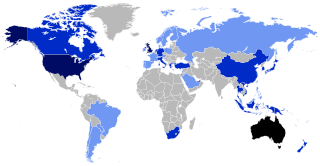
Australians, colloquially known as Aussies, are the citizens, nationals and individuals associated with the country of Australia. This connection may be residential, legal, historical or ethno-cultural. For most Australians, several of these connections exist and are collectively the source of their being Australian. Australian law does not provide for a racial or ethnic component of nationality, instead relying on citizenship as a legal status.
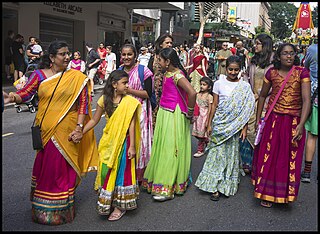
Indian Australians or Indo-Australians are Australians of Indian ancestry. This includes both those who are Australian by birth, and those born in India or elsewhere in the Indian diaspora. Indian Australians are one of the largest groups within the Indian diaspora, with 783,958 persons declaring Indian ancestry at the 2021 census, representing 3.1% of the Australian population. In 2019, the Australian Bureau of Statistics estimated that 721,050 Australian residents were born in India.

Scottish Australians are residents of Australia who are fully or partially of Scottish descent.
The British diaspora consists of people of English, Scottish, Welsh, Northern Irish, Cornish, Manx and Channel Islands ancestral descent who live outside of the United Kingdom and its Crown Dependencies.
The English diaspora consists of English people and their descendants who emigrated from England. The diaspora is concentrated in the English-speaking world in countries such as the United States, Canada, Australia, New Zealand, Scotland, Ireland, Wales, South Africa, India and to a lesser extent, Zimbabwe, Zambia and continental Europe.
The English people are an ethnic group and nation native to England, who speak the English language, a West Germanic language, and share a common ancestry, history, and culture. The English identity began with the Anglo-Saxons, when they were known as the Angelcynn, meaning race or tribe of the Angles. Their ethnonym is derived from the Angles, one of the Germanic peoples who migrated to Britain around the 5th century AD.
European Australians are citizens or residents of Australia whose ancestry originates from the peoples of Europe. They form the largest panethnic group in the country. At the 2021 census, the number of ancestry responses categorised within European ancestral groups as a proportion of the total population amounted to more than 57.2%. It is impossible to quantify the precise proportion of the population with European ancestry. For instance, many census recipients nominated two European ancestries, tending towards an overcount. Conversely, 29.9% of census recipients nominated "Australian" ancestry, tending towards an undercount.

New Zealand Australians refers to Australian citizens whose origins are in New Zealand, as well as New Zealand migrants and expatriates based in Australia. Migration from New Zealand to Australia is a common phenomenon, given Australia's proximity to New Zealand, its larger economy, free movement agreement and cultural links between the two countries.
The 2016 Australian census was the 17th national population census held in Australia. The census was officially conducted with effect on Tuesday, 9 August 2016. The total population of the Commonwealth of Australia was counted as 23,401,892 – an increase of 8.8 per cent or 1,894,175 people over the 2011 census. Norfolk Island joined the census for the first time in 2016, adding 1,748 to the population.
Norfolk Islanders, also referred to as just Islanders, are the inhabitants or residents of Norfolk Island, an external territory of Australia. The Islanders have their own unique identity and are predominantly people of Pitcairn and English descent and to a lesser extent of Scottish and Irish.
